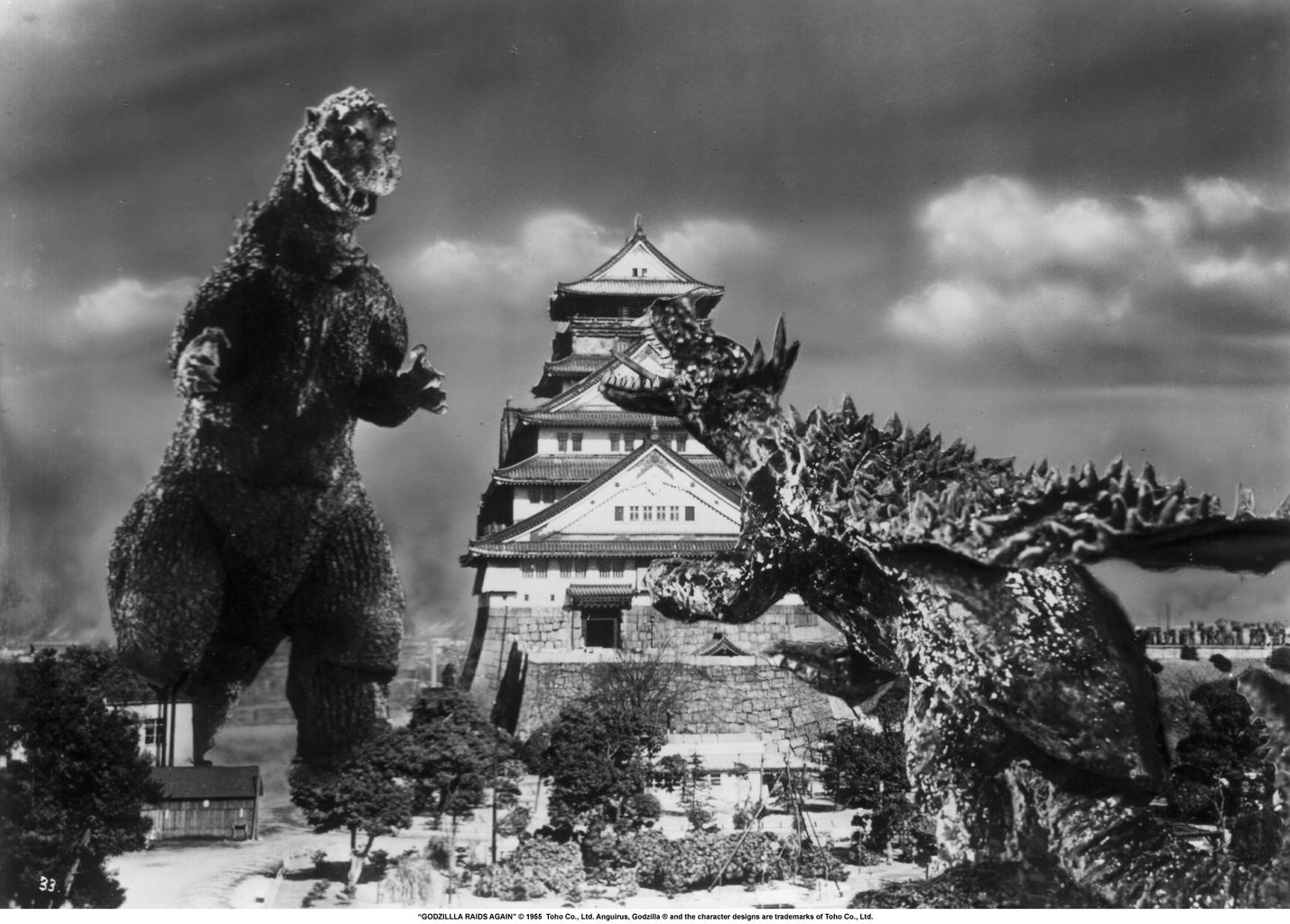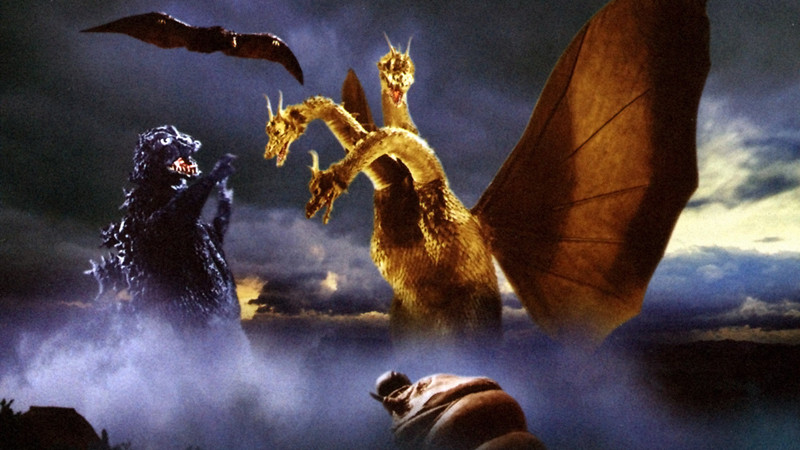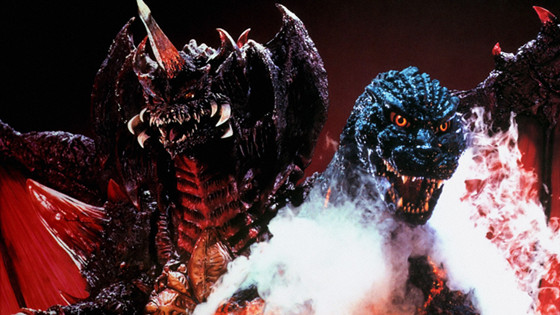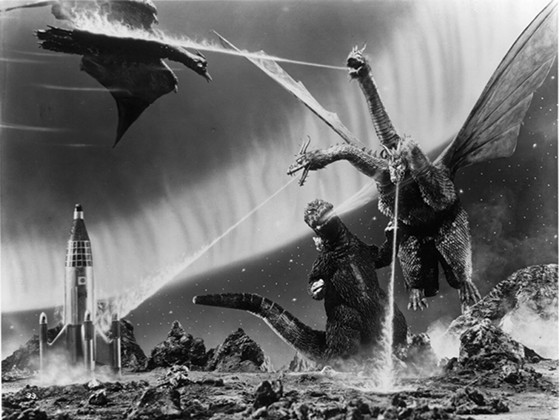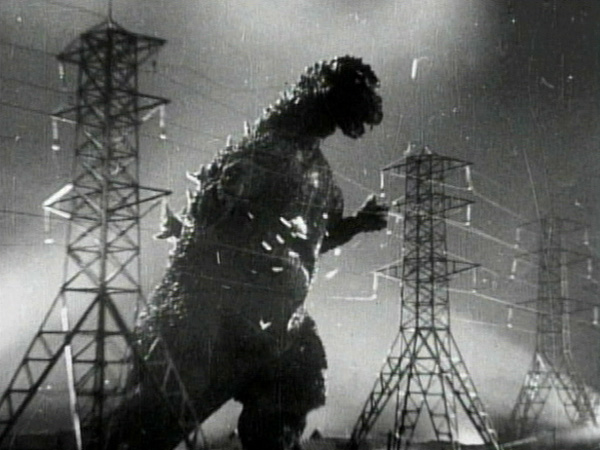5. Godzilla Raids Again aka Gigantis The Fire Monster
This is an important entry to include on the list for several reasons. It was the second Godzilla film made (mere months after the release and success of the first), the only one in black and white other than the original Gojira, and the first one to show Godzilla fighting another monster. It also has an interesting history, at least for American audiences. For years it was known in the States as Gigantis the Fire Monster, renamed after its acquisition in 1958 by producers Paul Schreibman, Edmund Goldman and Newton P. Jacobs.
The reason for the dramatic name change isn’t exactly clear, and moviegoers weren’t terribly excited by the weirdly dubbed (listen for the “banana oil” line) and badly re-edited film (fun fact: Star Trek’s George Takei was one of the voice actors who worked on the English dub). As with Gojira’s transition into Godzilla, King of the Monsters, key plot points were removed, and different footage was added to alter the story.
It was decades before the uncut and unaltered Godzilla Raids Again was released to video in North America. As such, it isn’t the strongest film in the series, but it is a very interesting one. Made in a rush (once the producer of Gojira saw how successful that film had become, he ordered up a sequel to be completed within six months), there are some amusing technical errors, the most memorable of which being the fact that the monster fights were accidentally shot at low speed instead of the typical high speed used to generate a sense of ponderous movement, the end result being that Godzilla and his mortal enemy Anguirus look as if they’re in a Benny Hill sketch.
The story is far less science fiction oriented, focusing mainly on a young pilot working for a fish canning company who is the first to discover the monsters. His romantic subplot makes one wonder if the filmmakers didn’t just dig up a script for an unproduced melodrama and drop a couple of monsters into it.
To be fair, the effects are about on a par with the first film, and there’s a thrilling finale were Godzilla is repeatedly bombed while stomping around on an iceberg, burying him under thousands of tons of ice. Because of the relative financial failure of this sequel, it wouldn’t be until 1962 that Godzilla would burst out of that pile of ice for his battle with a funny gorilla costume in King Kong Vs. Godzilla.
4. Ghidorah, The Three Headed Monster
Ghidorah begins what I consider to be the Rat Pack Period of Godzilla films, movies set right squarely in the mid-Sixties that have shed the stylish influences of the previous decade and are just beginning to adopt the swingin’ atmosphere of a Tiki bar in Vegas. One can almost imagine Dean Martin and Sammy Davis Jr. turning up for brief cameos as Godzilla and his multiple foes wreak havoc throughout the hapless cities and towns of Japan.
Godzilla gets to be a good guy this time, doing battle with Rodan (who wakes up from the volcanic grave he fell into in his debut film), Mothra (who he just got done fighting in the film that preceded this one) and the formidable King Ghidorah, a three-headed, lightning-spewing flying dragon that has already destroyed all civilization on Venus (or Mars, depending on whether you’re watching the English or Japanese version).
All of these events are predicted by a young princess thought to have died when a bomb blew up her plane, but as it turns out she was delivered from her fate by an alien spirit that has possessed her body. This is the first instance of extraterrestrials playing a part in the plot of a Godzilla movie, kicking off a trend that would affect the series for years to come. It’s also the first time Godzilla has to cooperate with other monsters to defeat a common foe, though in this case both he and Rodan are reluctant to do so (and yes, the monsters literally talk the idea over for a bit).
I don’t remember the humor being so overt at any point prior to this—it turns into all-out slapstick, and to be frank, a lot of it works. The bit where Rodan laughs as Godzilla gets sprayed in the face by the larval Mothra’s silk, only to do a quick double-take as he finds himself getting the same treatment, is priceless. It’s at this point in the series that the campy tone that would come to prevail for the next few decades really got its start.
3. Godzilla Vs. Destoroyah
The Heisei Series is a little hit or miss in my opinion, producing in its run just a tiny handful of genuinely watchable films (the interesting Godzilla Vs. Biollante and the odd Godzilla Vs. King Ghidorah being two of them), but the last of the series is in most respects as good or better than many of the films that came before it.
An over-irradiated Godzilla is judged by the scientific community of being on the verge of total meltdown. What this means is that he is likely to either explode (killing everybody) or literally melt and burn a hole all the way to the Earth’s core (also killing everybody). The only thing to do is to shoot him with freezing chemicals that will hopefully arrest or contain the disaster. The only problem is that a new version of the Oxygen Destroyer that killed the original Godzilla has been developed, leading to the creation of mutated fossil creatures that quickly grow into grotesque, Predator-like monsters intent on threatening both Godzilla and humanity.
Godzilla Vs. Destaroyah is not only the best in the Heisei Series, but easily among the best of the entire 60-year franchise. What it brings is a rare note of pathos that cuts through what might otherwise be perceived as yet more silly men in monster costumes wrecking cardboard cities, eliciting genuine emotion as our long-suffering anti-hero succumbs to the effects of lifelong radiation exposure.
Godzilla looks great here, a steaming, smoking cauldron that towers like a living nuclear reactor, striped in patches of glowing fire. Really, this is how he should look all the time. His mutated adversary is great too, the design integrating aspects of H.R. Giger’s Alien with the more traditional proportions of classic kaiju. Baby Godzilla is an important part of the story as well, coming off much less cartoonish than in previous incarnations, and giving the film an even greater emotional richness that helps to set it apart from the rest of the crowd.
Godzilla Vs. Destaroyah was planned by Toho as the capper to the Heisei Series in anticipation of the 1998 American Godzilla remake. One can only assume they thought the supposedly inevitable success of the film would launch a number of sequels that would make Toho a bundle in licensing and overseas distribution. Once they saw the box office returns on that dud, the next step was was to immediately get to work on Godzilla 2000.
2. Invasion of Astro-Monster aka Godzilla Vs. Monster Zero
Much of the wackiness that got rolling in Ghirdorah The Three-Headed Monster became intensified in Invasion of Astro-Monster (known as Monster Zero or Godzilla Vs. Monster Zero for years in the American market), achieving a level of sublime camp that it might be safe to say was never equaled in subsequent films. I should admit to personal bias in this case; Astro-Monster was the first Godzilla movie I ever saw, at around the age of six or seven, broadcast out of Bellingham, WA on KVOS as a part of a week-long Godzilla marathon. It should come as no surprise, then, that I tend to prefer movies from this period, and I feel justified in that preference by how spectacular Astro Monster and the films roughly contemporary with it look on recent DVD transfers. The photography is gorgeous, and the effects are fantastic for their era.
This is probably as good a place as any to mention director Ishiro Honda and special effects wizard Eiji Tsuburaya, two men whose work is probably most responsible for making the Showa Godzilla series what it was and led to the following these films would develop in later years. Honda directed a great deal of Toho Studio’s science fiction projects, including but not limited to the original Gojira, Rodan, Mothra, The Mysterians, and War of the Gargantuas.
You wouldn’t expect so much attention to details such as shot composition and engaging storytelling to go into movies that many dismiss as simple childrens’ fare, but it isn’t so hard to imagine when you consider that he was a close friend of Akira Kurosawa’s, who worked at Toho at the same time as Honda (a fact that has led to more than one midnight reverie where I think of an alternate universe where Honda directed samurai movies and Kurosawa helmed stories about giant radioactive monsters).
Effects master Tsuburaya’s work is legendary; he’s largely credited with creating the “suitmation” style of kaiju monster that the world generally associates with Godzilla films, not to mention the myriad miniature effects showcased in the Showa series and other Toho productions. It’s rumored that he even went so far as to furnish every tiny room in the buildings Godzilla and his cronies demolish.
Astro-Monster is the first Godzilla movie where aliens truly run riot throughout the story, and they’re really something. Arriving on hubcap-shaped flying saucers with a promise to cure all Earthly disease, they have a grey pallor and wear grey-and-black jumpsuits with wraparound shades. Of course, their true intentions come to light when they threaten to destroy Earth by controlling Godzilla, Rodan and King Ghidorah. A Godzilla movie can’t be all monster fights, there must also be a supporting story between bouts, and Astro-Monster has probably one of the most entertaining. On top of that it is the only film I can think of where Godzilla dances, just so fans of Godzilla-boogie don’t feel left out.
1. Gojira aka Godzilla, King of the Monsters
I suppose you’re not surprised this one’s on the list. Obviously no discussion of the Godzilla filmography would be complete without the very first, the original, and the best Godzilla movie. Let’s clarify something before we continue: I’m talking about the Japanese version of Godzilla, not the American version released two years later, dubbed into English with scenes of Raymond Burr talking to doubles standing in for the Japanese actors. While that’s the one many audiences around the world are familiar with, it’s a markedly inferior film for taking what is a fairly straightforward, beautifully tragic story and making it center around an American character.
Gojira is in no way an American story—in it’s depiction of a scientist sacrificing his own life in order to prevent the world from using his Oxygen Destroyer toward evil ends, leading to one of the most downbeat endings in ’50’s sci-fi cinema, there is a distinctly Japanese feel to the proceedings. Godzilla is a monster born out of Japan’s direct experience with the effects of atomic weaponry, and it stands to reason that filmmakers from that country, producing a motion picture for a Japanese audience only ten years after the destruction of Hiroshima and Nagasaki, would wish to explore the emotional after-effects of those events through metaphors made possible by the science fiction genre.
Godzilla is himself a living personification of a nuclear blast, whose inexorable trail of devastation through Tokyo is as total as it is unstoppable. In that sense, Godzilla could be seen as a symbol for the United States itself, or any world power that wields the ability employ large-scale mass murder on a whim. A third interpretation of the character is that he embodies fascist Japan in the ’30’s and ’40’s—like that regime, he is finally brought low by a weapon of mass destruction, which its inventor takes the most extreme measures to erase from existence, as if to say, “After this, no more—there can be no rational justification to use this kind of weapon ever again.”
Out of all Godzilla films, this is easily the most serious, standing head and shoulders above any sci-fi movies being produced in the US around that time. The special effects, though often derided today as unrealistic and cheesy, were cutting edge in their day, showing a level of detail and care that had no corollary in world cinema. Topping it all off is a thunderous, exciting, and sometimes heartbreaking score by Akira Ifukube.
Author Bio: Scot Mason lives in Tucson, AZ. He is the author of the blogs Hawaii Timewarp, Eastern Trails, Scotty’s Movies N’ Tunes, and Tucson Only Kind Of Sucks. He once lived in a shack in the middle of an abandoned sugercane field full of giant spiders and rats, because YOLO.
